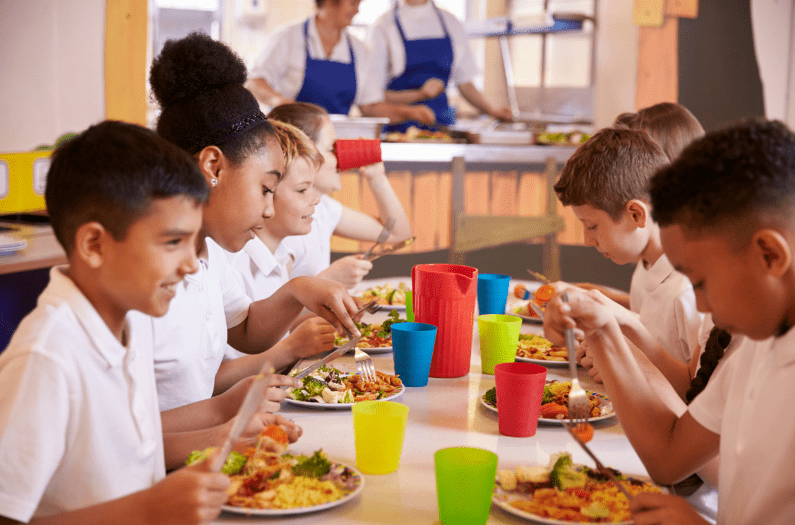Children are little sponges, you’ve probably heard this before. They absorb everything around them, repeat everything they hear, and repeat actions they see. Moreover, they adapt to the behavioral patterns around which they spend most of their time.
Parents are one of the most powerful influences on them and it is their responsibility to set an example. However, we live in a world of labels, eating disorders, and diets. Teaching children about food in a healthy and positive way can be challenging.
The rate of childhood obesity has tripled in the last 40 years. We have to admit that it is much easier to order something quickly than to prepare food at home. Childhood obesity and eating disorders are extremely dangerous, but so are the ”good” and ”bad” labels. These can lead to a dysfunctional relationship with food.
The aim is to present food in a positive and open approach. We need to give children the option to choose their own food knowing the nutritional value of the food they eat.
Many times, parents will label sugary and fried foods (such as French fries, doughnuts, and cookies) as ”bad”. On the other hand, fruits and vegetables are ”good”. These labels can create a judgmental image of food in the eyes of little ones.
Lesson #1: Don’t Label Foods as ”Good” or ”Bad”
Of course, we don’t want our little ones to eat five bags of chips and a pound of candy daily. So it is important to explain to them why some foods can help them become strong and other foods are just for fun and rarely eaten. You can use the example of foods that are always kept in the house (such as fruits, and vegetables) and fun foods that are only sometimes kept in the house (such as sweets). After all, we all like to treat ourselves to a piece of cake once in a while, and it’s totally okay to do so as long as we regularly balance the balance with nutritious foods.
Lesson #2: Try again and again
Children’s taste buds develop over time, so it is important to continue to offer them a variety of foods, even if they were not a success at first. You may have to offer a new food several times before your little one accepts it. Therefore offer new foods alongside familiar ones and always encourage them to try a mouthful of the new food. But if you receive a refusal, do not insist under any circumstances!
And since the kids are watching, you have to eat your vegetables!



Lesson #3: Involve them in the process
Children love to learn, get their hands dirty and help their parents. Cooking is a great way to show children how to prepare a nutritious meal, allowing them to use their creative side. You can talk them through each ingredient throughout the entire process. These fun activities can inspire a desire to be involved in family meals and cook for their future families.
Another great way to get kids involved is to plant vegetables or herbs with them. They can learn the nutritional benefits of each plant as they watch them grow.
Lesson #4: Keep certain information to yourself
Whether you’re on an intense exercise program or a calorie-restricted diet, don’t share this lifestyle with your children. Even if you’re losing weight in a healthy and responsible way, telling kids that ”carbs are bad” or ”I need to exercise to lose weight” can create a negative image of food and exercise. This can lead them to resort to diets and induce the thought that exercise is a punishment and not a reward for what your body can become.
Lesson #5: Educate children to live a healthy life rather than focusing on an ideal weight
Overweight children are often teased in school, and childhood weight gain can lead to chronic health conditions such as diabetes and heart disease. Instead of talking about gaining and losing weight, you better introduce the concept of a healthy lifestyle. A lifestyle that includes cooking nutritious food, playing in a team, and eating sweets in moderation.



Lesson #6: Forget ”Eat everything off your plate!”
Children have a more developed sense of hunger and satiety than adults. When we encourage them to eat more than they need, we do them a disservice. As a parent, it is your responsibility to provide nutritious meals and provide an appropriate portion at the beginning of the meal. Allow your child to stop if he tells you he is fed up. Make extra fruit, lean protein, whole grains, and vegetables available if they’re still hungry.
Lesson #7: Talk about your body in a positive way
Enjoy the fact that bodies come into this world in all shapes and sizes and use positive body language to describe your body. Do not use mocking language. Positive language involves talking in a pleasant way about both your body and the bodies of other people. It would be best if you emphasized that sports are healthy, but they are also done for fun, not to get into a certain body shape. Try never to talk disrespectfully about other people’s bodies. Children are very attentive to our reactions and comments, they internalize and repeat them. Give them words that are worth repeating, both to others and to themselves.
This article was taken and translated from the website psychologytoday.com. The original was written by Kristen Fuller, MD in collaboration with Rebecca Mason, RD
We hope the information was helpful. You can follow us on Instagram or Facebook .
Naaroo on Instagram



0 Comments for “How to talk to children about food – 7 tips for healthy food education”